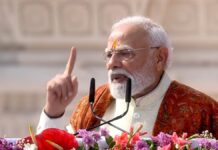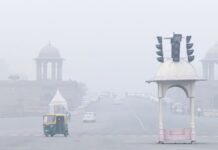X: @the_news_21
In its latest Monetary Policy Committee (MPC) meeting held on February 8, the Reserve Bank of India (RBI) opted to keep its key policy rate unchanged at 6.5 percent, marking the sixth consecutive occasion of maintaining a status quo. The decision, announced by RBI Governor Shaktikanta Das, underscores the central bank’s commitment to fostering stability amidst ongoing economic uncertainties.
Governor Das highlighted the persistent uncertainty in food prices as a factor impacting headline inflation, while also noting the sustained momentum in domestic economic activities. Emphasizing the need for an actively dis-inflationary monetary policy stance, Das reiterated the importance of anchoring inflation expectations within the target range.
The decision to maintain the status quo on the policy rate saw five out of six MPC members voting in favor, signaling a broad consensus on the prevailing economic conditions and the appropriate monetary policy response.
Looking ahead, Governor Das provided insights into the global economic outlook, projecting steady global growth in 2024 with variations across regions. Despite subdued global trade momentum, signs of recovery are emerging, with expectations of accelerated growth in the coming year. Additionally, inflationary pressures have softened considerably and are anticipated to further moderate in 2024, providing a favorable backdrop for monetary policy decisions.
This decision follows the previous MPC meeting held on December 8, where the central bank also opted to maintain the repo rate unchanged for the fifth consecutive time. During that meeting, Governor Das had revised the growth projection for the current financial year upwards to 7 percent, reflecting the resilience and potential of the Indian economy amidst challenges.
The MPC, tasked with determining the policy repo rate to achieve the inflation target while fostering growth, operates within the framework of promoting economic stability and sustainable development.
Despite a decline in retail inflation from its peak in July 2023, the current inflation rate, at 5.69 percent in December 2023, remains elevated albeit within the RBI’s comfort zone of 4-6 percent. This underscores the ongoing challenges in managing inflationary pressures amidst evolving economic dynamics.
Governor Das’ recent remarks echo his earlier sentiments regarding the Indian economy’s growth prospects and inflation trajectory. He had expressed optimism about achieving a growth rate of 7 percent in the upcoming financial year, alongside expectations of further easing in inflation. Additionally, he credited the government for its structural reforms, which have bolstered the economy’s medium and long-term growth potential.
As India charts its path towards economic recovery and sustainable growth, both monetary and fiscal policies remain crucial instruments in navigating uncertainties and fostering resilience. With a focus on reducing the budget deficit and advancing long-term reforms, policymakers aim to steer the economy towards a trajectory of inclusive and sustainable development.
Also Read: Pune Court Summons Railway Over Unauthorized Commuters in Divyang Coach







can you get clomid prices buying generic clomid tablets how can i get cheap clomid without dr prescription can i buy clomid price can i order generic clomid for sale how to buy generic clomiphene pill can you buy generic clomid without a prescription
The thoroughness in this piece is noteworthy.
Ramatogel adalah tempat membawa keberuntungan terbesar di Indonesia dan menyediakan persentase tertinggi mari gabung sekarang di ramatogel dapatkan bonus fantastis setiap hari
Proof blog you be undergoing here.. It’s severely to on elevated quality script like yours these days. I justifiably comprehend individuals like you! Withstand vigilance!!
azithromycin usa – buy tinidazole 300mg buy metronidazole 200mg generic
order domperidone – tetracycline 500mg ca order flexeril 15mg pills
buy amoxil tablets – purchase amoxicillin generic order ipratropium 100mcg without prescription
buy augmentin 375mg – atbioinfo.com cost acillin
esomeprazole 20mg drug – https://anexamate.com/ nexium sale
coumadin 5mg brand – https://coumamide.com/ order cozaar 25mg pill
order meloxicam 15mg online – swelling meloxicam over the counter
prednisone 5mg uk – aprep lson prednisone 5mg over the counter
hims ed pills – site top ed drugs
brand amoxil – cheap amoxil online cheap generic amoxil
diflucan oral – https://gpdifluca.com/ buy diflucan 200mg
buy cheap cenforce – cenforce 50mg cost purchase cenforce
typical cialis prescription strength – ciltad genesis where to buy cialis soft tabs
order ranitidine 150mg for sale – https://aranitidine.com/ buy zantac 150mg without prescription
cialis experience – https://strongtadafl.com/# buy cialis without a prescription
This is the description of topic I enjoy reading. this
buy cheap viagra with mastercard – https://strongvpls.com/# generic sildenafil 100mg
Thanks for sharing. It’s top quality. https://ursxdol.com/get-cialis-professional/
Thanks recompense sharing. It’s acme quality. https://buyfastonl.com/furosemide.html
The reconditeness in this serving is exceptional. https://prohnrg.com/product/diltiazem-online/
I’ll certainly bring back to review more. https://ondactone.com/product/domperidone/
More posts like this would prosper the blogosphere more useful.
https://doxycyclinege.com/pro/tamsulosin/
Thanks recompense sharing. It’s first quality. http://mi.minfish.com/home.php?mod=space&uid=1412621
dapagliflozin brand – order dapagliflozin dapagliflozin cheap
buy generic xenical – janozin.com orlistat without prescription
This is the kind of writing I in fact appreciate. http://furiouslyeclectic.com/forum/member.php?action=profile&uid=24865
You can protect yourself and your dearest by way of being wary when buying medicine online. Some pharmacy websites function legally and sell convenience, privacy, bring in savings and safeguards to purchasing medicines. buy in TerbinaPharmacy https://terbinafines.com/product/crestor.html crestor
The thoroughness in this break down is noteworthy. coumadin 2mg for sale
More posts like this would create the online elbow-room more useful.
搭载智能站群程序,自动化搭建与管理,为SEO项目提供核心驱动力。站群程序